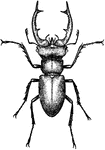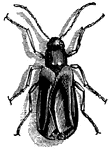
Sitaris Humeralis
"The female Sitaris Humeralis lays at the entrance of the nest of a solitary bee from 2,000…

First Larva of Sitaris Humeralis
"A month afterward there come out of these eggs very small larvae, of a shining dark green, hard-skinned,…

Pseudo Nymph of Sitaris Humeralis
"When the male bees have built the cells and furnished them with honey, the female, as we know, deposits…

Pupa of Sitaris Humeralis
The second larva stage lasts for 6 weeks. It contracts and passes through the winter. "In the spring…

Third Larva of Sitaris Humeralis
The second larva stage lasts for 6 weeks. It contracts and passes through the winter. "In the spring…

Stag Beetle
Lucanus Dama, the most common stag beetle in which the mandibles of the male are much enlarged and sickle-shaped;…

Stag Beetle (Lucanus Cervus)
"They live in half rotten trees. Their strength enables them to lift considerable wieghts. They do not…
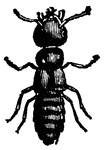
Imago of Staphylinus (Ocypus) Olens
"This specimen lives in the carcasses of animals, on manure, and attacks living insects. It is a carnivorous,…

Larva of Staphylinus (Ocypus) Olens
"This specimen lives in the carcasses of animals, on manure, and attacks living insects. It is a carnivorous,…
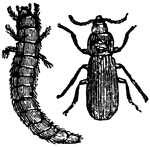
Tenebrio Molitor (Larva and Imago)
"A blackish-brown insect. The larvae are the well-known meal-worms, which live in flour."

Tiger Beetle (Cicindela Heros)
"Their ferocity is remarkable. They quickly tear off the wings and legs of their victim, and suck out…

Under Side of Pupa of Tiger Beetle (Cicindela Heros)
"Their ferocity is remarkable. They quickly tear off the wings and legs of their victim, and suck out…
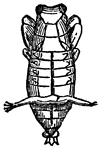
Upper Side of Pupa of Tiger Beetle (Cicindela Heros)
"Their ferocity is remarkable. They quickly tear off the wings and legs of their victim, and suck out…

Xylotrupes Dichotomus
"A common specimen about an inch long, of a chestnut brown and perfectly smooth. The male, but not the…
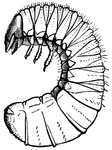
Grubworms
White grubs or Grubworms are the larvae of scarabs (beetles). Grubs commonly attack the roots of turfgrasses…
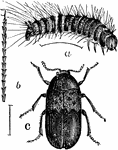
Larder Beetle Larvae and Imago
"Figure 10- Dermestes lardarius (Larder beetle) enlarged. a, larva; b, an enlarged hair; c, imago."…

Weevil
A weevil is any beetle from the Curculionoidea superfamily. They are usually small, less than 6 mm (¼…
